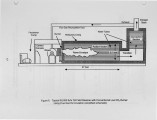| OCR Text |
Show The RSB concept of forming adjacent radiant and blue-flame zones on the burner surface offers a number of advantages over fully perforated metal bumers: • Lower NOx emissions at a fixed excess air level • Greater flame stability, allowing operation at high flue gas recirculation (FGR) levels or with low Btu fuels • Greater operating range without combustion-induced noise Two mechanisms are believed to contribute to the NOx reduction observed in the RSB. The first mechanism is a rapid post-flame cooling of each blue-flame zone. By spreading the flame over a large bumer surface, and by further increasing the surface area of the flame by altemating the radiant and blue-flame zones, the flame radiates energy to the boiler or process tubes at a higher rate than a conventional flame. A second mechanism is the intemal FGR effect produced by the entrainment of the products of combustion from the adjacent radiant zones into the blue flame. In the radiant zone, the combustion reaction is completed a few millimeters downstream of the burner surface. The combustion products initially serve to stabilize the attachment of the blue flame above the perforated portion of the bumer as well as to introduce lower temperature gas into the blue flame. Both effects reduce the flame temperature and the corresponding NOx formation rate. Prior to the completion of the work described in this paper, the RSB was demonstrated to achieve 30 ppm NOx at moderate levels of excess air and 9 ppm NOx at high excess air. The goal of the recently completed work was to reduce NOx emissions to sub-9 ppm levels and CO emissions to sub-50 ppm, while operating the burner at 2 to 3% stack O2. 2. NOx REDUCTION TECHNIQUES Previous work with the RSB demonstrated that NOx emissions below 9 ppm were achieved at 500/0 excess air. In fact, any desired NOx emissions level can be achieved by a simple excess air adjustment to provide a low NOx burner (less than 30 ppm) or an ultra-low NOx burner (less than 10 ppm). The advantage of this NOx reduction technique is its simplicity in controls and its high reliability and low maintenance requirements. However, for many industrial processes, the additional 2 |























